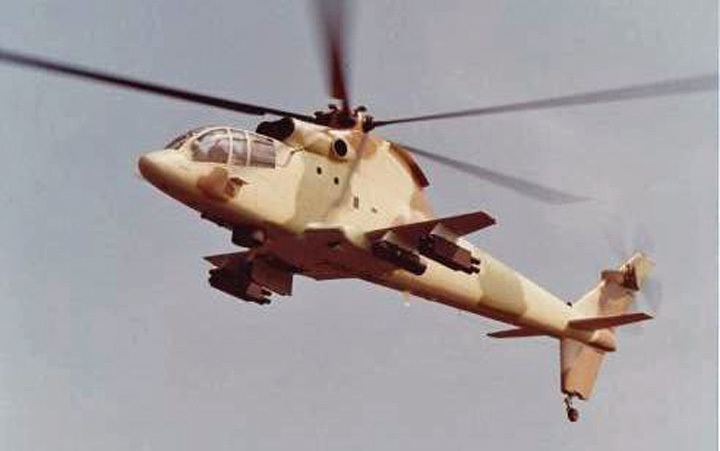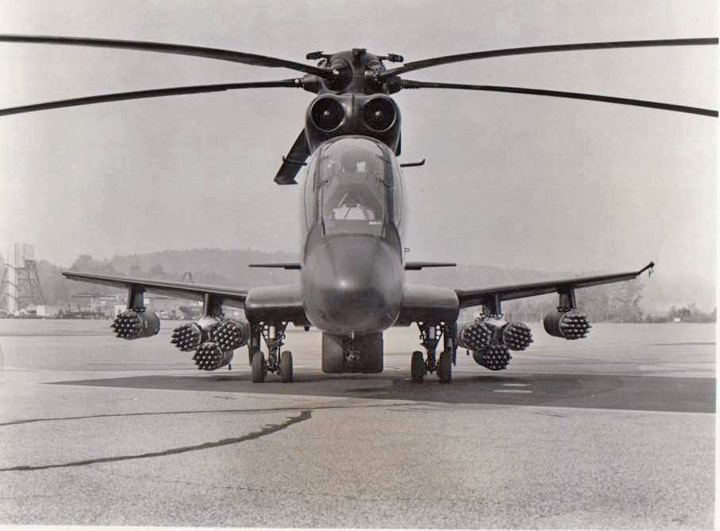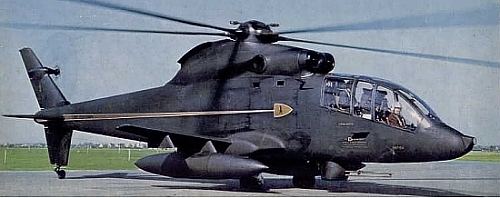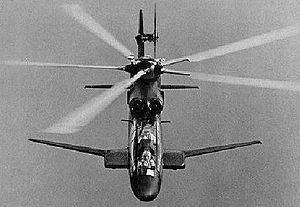Top speed 311 km/h Wingspan 19 m Cruise speed 269 km/h First flight August 20, 1970 | Range 354 km Length 23 m | |
 | ||
The Sikorsky S-67 Blackhawk was a private-venture, prototype attack helicopter built in 1970 with Sikorsky Aircraft research and development (R&D) funds. A tandem, two-seat aircraft designed around the dynamic drive and rotor systems of the Sikorsky S-61, it was designed to serve as an attack helicopter or to transport up to eight troops into combat.
Contents
- AAFSS and S 66 bid
- S 67 development
- Evaluation and records
- Fatal crash and afterwards
- Specifications S 67 Blackhawk
- References

AAFSS and S-66 bid

The US Army issued a request for proposals (RFP) for its Advanced Aerial Fire Support System (AAFSS) program on 1 August 1964. Lockheed offered its CL-840 design, a rigid-rotor compound helicopter. Sikorsky submitted the S-66, which featured a "Rotorprop" serving as a tail rotor but as speeds increased would rotate 90° to act as pusher prop. The S-66 had short, fixed wings and was powered by a 3,400 shp (2,500 kW) Lycoming T55 turboshaft engine. The design was to have a speed of 200 knots (370 km/h) with the ability for 250 knots (460 km/h) for brief periods.

The Army awarded Lockheed and Sikorsky contracts for further study on 19 February 1965. On 3 November 1965, the Army announced Lockheed as the winner of the AAFSS program selection. The Army perceived Lockheed's design as less expensive, able to be available earlier, and that it would have less technical risk than Sikorsky's Rotorprop.
S-67 development

When the Armed Aerial Fire Support System program was delayed, Sikorsky offered an armed SH-3 Sea King (Sikorsky S-61) version initially. After further AAFSS problems, the company developed an intermediate, high-speed attack aircraft named the Sikorsky S-67 Blackhawk in 1970. Design work on the S-67 began in November 1969 with manufacturing following in February 1970. The Blackhawk first flew on 20 August 1970.
The S-67 featured a five-bladed main rotor and tail rotor. The main rotor was taken from the S-61, but was modified to have a hub fairing, swept main rotor blade tips and a special "alpha-1" linkage which was added to the main rotor controls to increase collective pitch sensitivity and so extend the collective pitch range. The 20° swept main rotor blade tips help to overcome a phenomenon called sub-multiple oscillating track (SMOT) that causes variations in tip track at high Mach numbers. These allowed the S-67 to achieve and maintain high cruise speeds. To reduce drag at high speed, the mainwheels retracted fully into the stub wing sponsons. It had speed brakes on the wing trailing edges that could be used to decrease speed or increase maneuverability.
The S-67 was fitted with a moving map display, a hands-on-collective radio tune control, and night vision systems. Its armament included a Tactical Armament Turret (TAT-140) with a 30 mm (1.2 in) cannon, and could carry 16 TOW missiles, 2.75-inch (70 mm) rockets, or AIM-9 Sidewinder air-to-air missiles. The Blackhawk was powered by two General Electric T58-GE-5 1,500 shaft horsepower (1,100 kW) engines.
Evaluation and records
The S-67 Blackhawk, along with the Bell 309 KingCobra, was put through a series of flight test evaluations in 1972 by the U.S. Army. Neither aircraft was selected to replace the AH-56 Cheyenne. Instead, the Army chose to create the new Advanced Attack Helicopter program, which would lead to the AH-64 Apache several years later.
The S-67 performed a series of aerobatic maneuvers during its various marketing tours, including rolls, split-S, and loops. The S-67 was reputed to be very smooth and responsive, in spite of its size and speed.
Piloted by Sikorsky Test Pilots Kurt Cannon and Byron Graham, the S-67 established two E-1 class world speed records on 14 December 1970 by flying at 348.97 km/h (217 mph) over a 3 km (1.9 mi) course, and 355.48 km/h (221 mph) on 15 to 25 km (9.3 to 16 mi) course on 19 December 1970. These records stood for eight years.
As part of internal Sikorsky R&D efforts, in 1974, the S-67 had a 3.5-foot-diameter (1.1 m) ducted fan fitted instead of its original conventional tail rotor. The S-67 with fan was tested over 29 flight hours to compare to the conventional tail. In this configuration it reached a speed of 230 mph (370 km/h) in a test dive. The original tail rotor and vertical tail fin were re-installed in August 1974.
Fatal crash and afterwards
The lone S-67 prototype crashed while conducting a low-level aerobatic demonstration at the Farnborough Airshow in September 1974. During a low-level roll maneuver, the nose dropped too close to the ground for safe completion of the maneuver. The aircraft struck the ground in a level attitude and immediately burst into flame. Sikorsky test pilot Stu Craig died on impact, and test pilot Kurt Cannon died nine days later from his injuries. Development work on the S-67 ceased after this accident.
The United States Army assigned the name Black Hawk to the Sikorsky UH-60 Black Hawk helicopter.
Specifications (S-67 Blackhawk)
Data from Illustrated Encyclopedia of Helicopters, Attack Helicopter Evaluation
General characteristics
Performance
Armament
